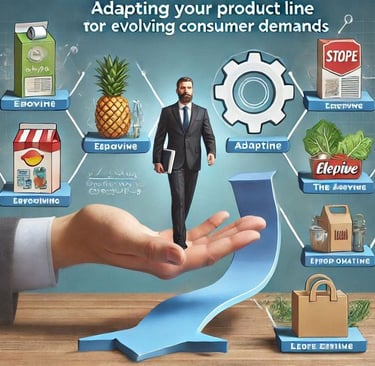Let us collaborate to foster global growth and development together.
Adapting Your Product Line to Meet Evolving Consumer Demands
Discover expert tips on adapting your product line to meet evolving consumer demands. Learn how to stay relevant and grow your business by staying responsive.
10/31/20244 min read


Meta Description: Discover expert tips on adapting your product line to meet evolving consumer demands. Learn how to stay relevant and grow your business by staying responsive.
Adapting Your Product Line to Meet Evolving Consumer Demands
In today’s fast-paced market, consumer preferences are shifting constantly. What consumers wanted last year may not be what they’re looking for now. As a business, adapting your product line to these evolving demands is essential not only for staying relevant but also for thriving in competitive markets. Whether you’re a small startup or an established brand, making informed changes to your product offerings can enhance customer loyalty, boost sales, and solidify your position in the market.
In this article, we will explore why adapting your product line to meet consumer demands is vital and share actionable strategies for successfully doing so. By the end, you’ll be equipped with the tools to ensure your business remains agile and responsive in the face of change.
Understanding the Importance of Adapting Your Product Line
Consumer demands are shaped by several factors, including technological advancements, cultural trends, economic shifts, and global events. With rapid innovation and increasingly diverse preferences, businesses must constantly evaluate their offerings to meet customer expectations.
Adaptation is key to survival. According to McKinsey & Company, consumer preferences have dramatically shifted over the last few years. Businesses that fail to adapt often struggle to maintain their market share. This is why analyzing and responding to these evolving demands is more critical than ever.
Why Product Adaptation Matters
Customer Retention: Customers are more likely to stay loyal to brands that meet their evolving needs. Failing to update your products can lead to declining relevance and loyalty.
Attracting New Audiences: New trends can attract entirely new customer segments. By innovating your product line, you open up the potential for growth.
Staying Competitive: Competition is fierce in nearly every industry. By regularly updating your product offerings, you differentiate your brand from others and avoid falling behind.
How to Adapt Your Product Line: Key Strategies
Adapting a product line doesn’t mean starting from scratch—it’s about listening to the market and being strategic with your approach. Here are several tips to guide your product adaptation efforts:
1. Conduct Regular Consumer Research
To successfully adapt your products to meet evolving demands, you first need to understand what those demands are. Conducting regular market research will give you critical insights into consumer behaviors, preferences, and unmet needs.
Surveys and Feedback: Use customer surveys, focus groups, and online reviews to gather direct feedback about your products. Understanding consumer satisfaction can uncover areas where your product line might be lacking or could be enhanced.
Social Listening: Pay attention to what consumers are saying about your products on social media. Platforms like Twitter, Instagram, and TikTok can offer valuable insights into emerging trends and consumer pain points.
Data Analytics: Analyze customer data to identify purchasing patterns and shifts. This can help you detect long-term trends that suggest it's time to adapt your product offerings.
2. Embrace Technology and Innovation
Innovation is one of the driving forces behind adapting your product line. Keeping up with technological advancements allows you to not only improve existing products but also develop entirely new solutions that resonate with evolving consumer demands.
Product Customization: With advanced manufacturing capabilities, product personalization is increasingly popular. Consumers are drawn to products that feel tailor-made for their specific needs and preferences.
Sustainable Products: Environmental concerns are increasingly shaping consumer choices. Introducing eco-friendly or sustainable options can increase the appeal of your product line.
Integrating Technology: Adding technological features such as app integration, smart functionalities, or virtual reality elements can make your products more engaging to modern consumers.
3. Diversify Your Product Line
Another way to adapt to consumer demands is by diversifying your product line. Consumers today are looking for variety and options that match their lifestyles and preferences. Having multiple versions of a product or adding complementary items to your portfolio can help you cater to a broader audience.
Versioning: Offer different versions of your core products to suit different needs and budgets (e.g., basic, premium, eco-friendly versions).
Add-Ons and Accessories: Consider creating accessories or related products that enhance the customer experience. For example, if you're selling a phone, complementary accessories like cases and chargers will add value to your customers’ purchases.
4. Focus on Customer Experience
It’s not just about the products themselves—today’s consumers place a high value on the experience you provide. This includes everything from personalized shopping experiences to excellent customer service. Your product line can be a part of this overall experience.
User-Centric Design: Ensure that your products are easy to use and add value to consumers’ daily lives.
Customer Support: Provide exceptional customer support services, such as easy returns or 24/7 live chat, to make customers feel valued and supported at every step of their buying journey.
Seamless Buying Experience: Consider creating a convenient and user-friendly digital shopping platform where customers can quickly find what they need and make purchases with ease.
How to Know When It's Time to Adapt Your Product Line
Knowing when to adapt your product line is just as important as knowing how to adapt it. Watch for these signs that indicate it's time for an update:
Declining Sales: If you notice that a particular product isn’t selling as well as it once did, it might be time to analyze whether consumer needs have shifted.
Changing Industry Trends: Keep an eye on emerging trends in your industry. If competitors are introducing innovative products or attracting new customers with their offerings, it could signal that it’s time for you to do the same.
Customer Feedback: Consistent feedback about missing features or dissatisfaction with certain aspects of your products is a clear indicator that changes are needed.
Conclusion: The Road Ahead for Your Business
Adapting your product line to meet evolving consumer demands is essential for maintaining market relevance and fueling long-term success. The key to achieving this lies in listening to your customers, embracing technological advances, and offering diverse solutions that cater to a wide range of needs. Stay agile, monitor market trends, and continuously innovate to keep your business ahead of the curve.
Do you have any strategies or insights about adapting your product line? Share your thoughts in the comments below, or explore our other articles on innovation in business to learn more!
Innovation
Cutting-edge solutions for industrial efficiency and productivity.
© 2024. All rights reserved.


